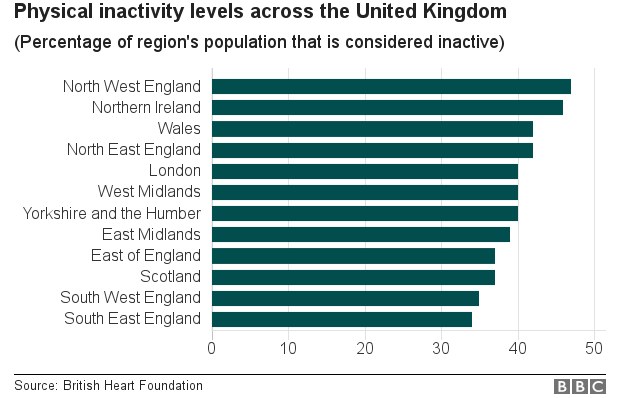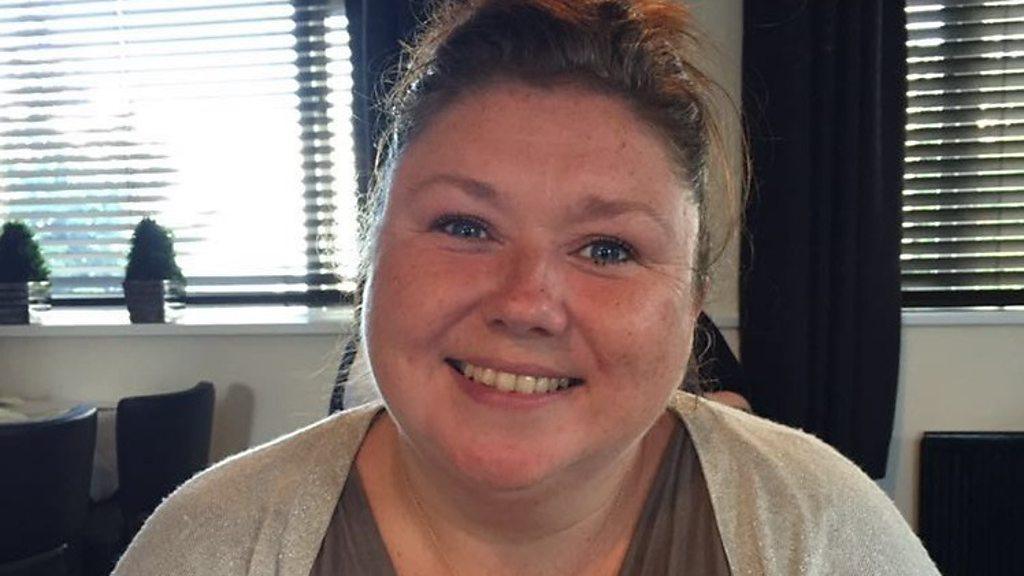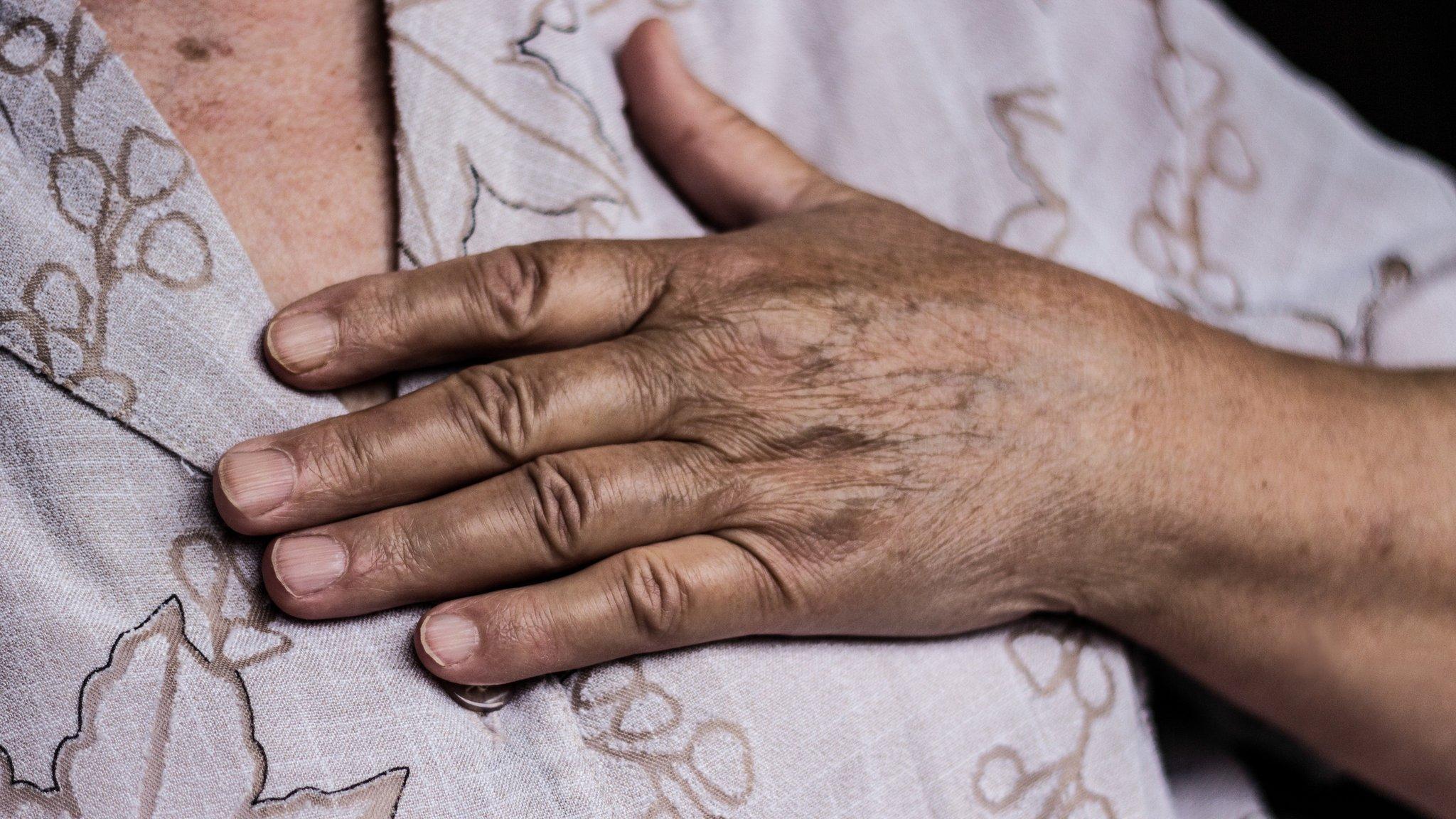More than 20 million Britons 'physically inactive'
- Published
Harriet Mulvaney says she thought she was active before her heart attack but she was really "just busy"
More than 20 million people in the UK are physically inactive, according to a report by the British Heart Foundation.
The charity warns that inactivity increases the risk of heart disease and costs the NHS around £1.2bn each year.
Harriet Mulvaney experienced a heart attack at 44 and decided to make changes to her lifestyle.
"Looking back on it now I would say I was very inactive. I thought I was active but actually I think I was just busy," she says.
Women are 36% more likely than men to be classified as physically inactive - 11.8 million women compared with 8.3 million men.
The report defines "inactive" as not achieving the government guidelines for physical activity of 150 minutes of moderate intensity physical activity a week and strength activities on at least two days a week.
Harriet had a busy life as an HR consultant, driving an hour to work and then sitting at a desk for eight to 10 hours a day.
She would then be busy with family life but didn't make time for activity or exercise.
"I just thought it was one of those things I'd get to in another point in time," she says.
The BHF analysis found that the average man in the UK spends a fifth of his lifetime sitting - equivalent to 78 days a year. For women, it is around 74 days a year.

Harriet had no symptoms or warning signs before her heart attack.
"I was climbing the stairs to go and brush my teeth and get ready for bed when I suddenly had the onset of severe chest pain which went down my left arm and into my upper jaw - it was at that point that I realised it was fairly serious.
'Crashing halt'
"We called an ambulance - which was exactly the right thing to do as the sooner you get help on a heart issue, the better your outcome is going to be."
Harriet had suffered from spontaneous coronary artery dissection (SCAD), external, a rare but dangerous condition which often strikes out of the blue and in people with few or no risk factors. It mainly affects young women.
"It was like having the rug pulled from under your feet," she says.
"You feel your life is going in a certain direction, you have a certain plan, you feel very confident about the way that your life is.
"I didn't have any long-term health conditions and then to suddenly be struck by such a traumatic incident was very difficult.
"It brought everything to a crashing halt for a short period of time while I collected myself and found myself again."
In the UK, physical inactivity contributes to almost one in 10 premature deaths from coronary heart disease, and one in six deaths from any cause.

Exercise guidelines for adults aged 19 to 64
How much?
At least 150 minutes of moderate aerobic activity or 75 minutes of vigorous aerobic activity every week
Strength exercises on two or more days a week that work all the major muscles
Break up long periods of sitting with light activity
What counts as moderate aerobic activity?
Walking fast, water aerobics, riding a bike on level ground or with few hills, doubles tennis, pushing a lawn mower, hiking, skateboarding, rollerblading, volleyball, basketball
What counts as vigorous activity?
Jogging or running, swimming fast, riding a bike fast or on hills, singles tennis, football, rugby, skipping rope, hockey, aerobics, gymnastics, martial arts
What activities strengthen muscles?
Lifting weights, working with resistance bands, doing exercises that use your own body weight, such as push-ups and sit-ups, heavy gardening, such as digging and shovelling, yoga.
What activities are both aerobic and muscle-strengthening?
Circuit training, aerobics, running, football, rugby, netball, hockey

Marathon woman
Harriet's heart attack prompted an immediate lifestyle change.
"I had to think about the job that I did and the life I was leading - and start generally looking after myself better."
She admits getting active has been "a very slow and steady process".
She took part in the BHF MyMarathon challenge that involves running or walking the equivalent of a marathon across a whole month.

Harriet went into cardiac rehab after her heart attack and was helped to get more active and build her confidence
The charity is hoping more people take up the challenge this year to kickstart a more active lifestyle.
They found that three-quarters of people in England (76%), when referred for rehabilitation after suffering a heart attack or having heart surgery, are considered physically inactive.
They warn that more than 5 million deaths worldwide can be attributed to physical inactivity, making it one of the top 10 leading causes of death.
Dr Mike Knapton, associate medical director at the British Heart Foundation, said: "Levels of physical inactivity and sedentary behaviour in the UK remain stubbornly high, and, combined, these two risk factors present a substantial threat to our cardiovascular health and risk of early death.
"Evidence shows keeping physically active can reduce the risk of heart and circulatory disease by as much as 35% and risk of early death by as much as 30%."
The charity also found regional variations, with the North West of England having 47%, or 2.7 million adults that are insufficiently active.
The South East had the lowest rate at 34%.
In Northern Ireland, almost half (46%) of the adult population - that's around 650,000 people - are deemed to be physically inactive.
In Wales, 42% of the population, more than one million people are physically inactive.
While in Scotland, 37% of the adult population, around 1.6 million people - are physically inactive.


- Published1 March 2017

- Published28 February 2017

- Published30 August 2016

- Published30 August 2016
